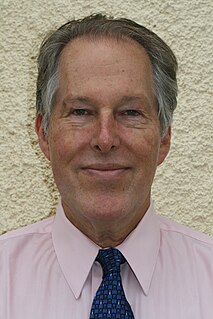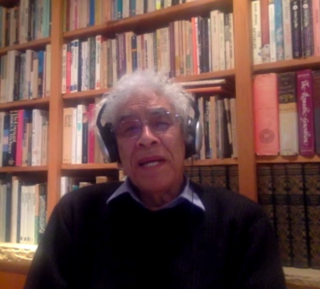Related Research Articles

Michael Evan Mann is an American climatologist and geophysicist. He is the director of the Earth System Science Center at Pennsylvania State University. Mann has contributed to the scientific understanding of historic climate change based on the temperature record of the past thousand years. He has pioneered techniques to find patterns in past climate change and to isolate climate signals from noisy data.

Kevin Edward Trenberth is part of the Climate Analysis Section at the US NCAR National Center for Atmospheric Research. He was a lead author of the 2001 and 2007 IPCC Scientific Assessment of Climate Change and serves on the Scientific Steering Group for the Climate Variability and Predictability (CLIVAR) program. He chaired the WCRP Observation and Assimilation Panel from 2004 to 2010 and chaired the Global Energy and Water Exchanges (GEWEX) scientific steering group from 2010 to 2013. In addition, he served on the Joint Scientific Committee of the World Climate Research Programme, and has made significant contributions to research into El Niño-Southern Oscillation.

Wallace "Wally" Smith Broecker was an American geochemist. He was the Newberry Professor in the Department of Earth and Environmental Sciences at Columbia University, a scientist at Columbia's Lamont-Doherty Earth Observatory and a sustainability fellow at Arizona State University. He developed the idea of a global "conveyor belt" linking the circulation of the global ocean and made major contributions to the science of the carbon cycle and the use of chemical tracers and isotope dating in oceanography. Broecker popularized the term "global warming". He received the Crafoord Prize and the Vetlesen Prize.

Charles David Keeling was an American scientist whose recording of carbon dioxide at the Mauna Loa Observatory confirmed Svante Arrhenius's proposition (1896) of the possibility of anthropogenic contribution to the "greenhouse effect" and global warming, by documenting the steadily rising carbon dioxide levels. The Keeling Curve measures the progressive buildup of carbon dioxide, a greenhouse gas, in the atmosphere.
The Lamont–Doherty Earth Observatory (LDEO) is the scientific research center of the Columbia Climate School, and a unit of The Earth Institute at Columbia University. It focuses on climate and earth sciences and is located on a 189-acre campus in Palisades, New York, 18 miles (29 km) north of Manhattan on the Hudson River.
Walter Clarkson Pitman III was an American geophysicist and a professor emeritus at Columbia University. His measurements of magnetic anomalies on the ocean floor supported the Morley–Vine–Matthews hypothesis explaining seafloor spreading. With William Ryan, he developed the Black Sea deluge theory. Among his major awards are the Alexander Agassiz Medal and the Vetlesen Prize.

Susan Solomon is an atmospheric chemist, working for most of her career at the National Oceanic and Atmospheric Administration. In 2011, Solomon joined the faculty at the Massachusetts Institute of Technology, where she serves as the Ellen Swallow Richards Professor of Atmospheric Chemistry & Climate Science. Solomon, with her colleagues, was the first to propose the chlorofluorocarbon free radical reaction mechanism that is the cause of the Antarctic ozone hole.
William Richard Peltier, Ph.D., D.Sc. (hc), is University Professor of Physics at the University of Toronto. He is director of the Centre for Global Change Science, past principal investigator of the Polar Climate Stability Network, and the Scientific Director of Canada's largest supercomputer centre, SciNet. He is a fellow of the Royal Society of Canada, of the American Geophysical Union, of the American Meteorological Society, and of the Norwegian Academy of Science and Letters..

Matthew England is a physical oceanographer and climate scientist. He is currently Scientia Professor of Ocean & Climate Dynamics at the University of New South Wales, Sydney, Australia.
Sverdrup Gold Medal Award – is the American Meteorological Society's award granted to researchers who make outstanding contributions to the scientific knowledge of interactions between the oceans and the atmosphere.

Richard Chapin James Somerville is an American climate scientist who is a Distinguished Professor Emeritus at Scripps Institution of Oceanography at the University of California, San Diego, where he has been a professor since 1979.
John Charles Marshall, FRS is a British oceanographer and academic. He is the Cecil and Ida Green Professor of Oceanography in the Department of Earth, Atmospheric and Planetary Sciences at the Massachusetts Institute of Technology (MIT). He is also an Adjunct Senior Research Scientist in the Department of Applied Physics and Applied Mathematics at Columbia University.
Adam A. Scaife FRMetS FInstP is a British physicist, and head of long range prediction at the Met Office. He is also a Professor at Exeter University. Scaife carries out research into long range weather forecasting and computer modelling of the climate and has published around 200 peer reviewed studies on atmospheric dynamics, computer modelling and climate as well as popular science and academic books on meteorology.

Peter John Webster is a meteorologist and climate dynamicist relating to the dynamics of large-scale coupled ocean-atmosphere systems of the tropics, notably the Asian monsoon. Webster holds degrees in applied physics, mathematics and meteorology. Webster studies the basic dynamics of the coupled ocean-atmosphere system in the tropics and has applied this basic knowledge to developing warning systems for extreme weather events in Asia. He has served on a number of prestigious national and international committees including the World Climate Research Program's Joint Scientific Committee (1983-1987), chaired the international Tropical Ocean Global Atmospheric (TOGA) organizing committee (1988–94) and was co-organizer of the multinational TOGA Couple Ocean-Atmosphere (1993). He is Emeritus Professor in Earth and Atmospheric Sciences at Georgia Institute of Technology and co-founder and Chief Scientist of Climate Forecast Applications Network LLC, a weather and climate services company.

Trevor John McDougallFAGU is a physical oceanographer specialising in ocean mixing and the thermodynamics of seawater. He is Scientia Professor of Ocean Physics in the School of Mathematics and Statistics at the University of New South Wales, Sydney, Australia. He is President of the International Association for the Physical Sciences of the Oceans (IAPSO) of the International Union of Geodesy and Geophysics.
Amy C. Clement is an atmospheric and marine scientist studying and modeling global climate change. Her research focuses on cloud albedo feedbacks, ocean circulation patterns, and the El Niño Southern Oscillation (ENSO). She is currently a professor at University of Miami's Rosenstiel School.
Peter George Baines is an Australian geophysicist. He is an Honorary Senior Fellow at University of Melbourne and Honorary Secretary at Royal Society of Victoria.

Samuel George Harker Philander is a climate scientist, known for his work on El Niño. He is the Knox Taylor Professor emeritus of Geosciences at Princeton University.
References
- ↑ "Mark Cane – Google Scholar Citations". scholar.google.com. Retrieved 2015-11-11.
- ↑ Cane, M.A.; S.E. Zebiak; S.C. Dolan (1986). "Experimental forecasts of El Niño". Nature . 321 (6073): 827–832. doi:10.1038/321827a0. S2CID 4303488.
- ↑ Rittner, Don (2009). A to Z of Scientists in Weather and Climate. Infobase Publishing. ISBN 978-1438109244.